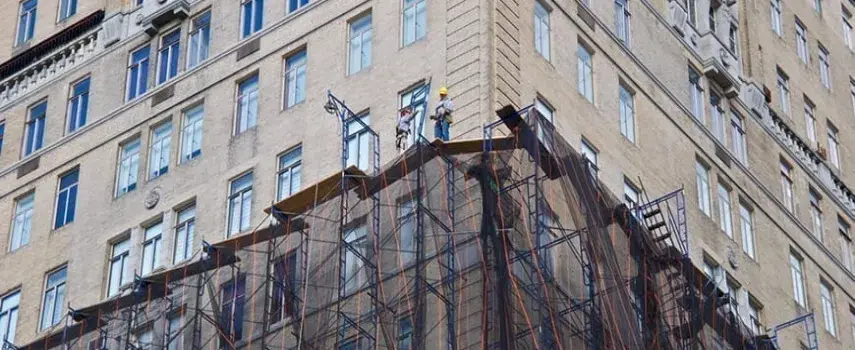Accidents involving scaffolding are common in New York and can result in injury to workers, visitors, and pedestrians. There are many hazards associated with working on a construction site, especially when it comes to using scaffolding. The materials from which the scaffolding is constructed, combined with exposure to the elements, require the implementation of specific health and safety procedures to minimize the risk of accidents.
Who Can Be Liable for an Accident?
- The construction company overseeing a construction site that does not comply with health and safety standards, as regulated by New York State and OSHA.
- The employee, if they did not follow the correct procedures while working on the site and behaved irrationally.
- The scaffolding supplier, if they provided the construction company with inappropriate or dangerous materials not suitable for use.
A scaffold that is not properly assembled can move or tip over, leading to serious construction accident injuries. Another risk associated with scaffolding is objects and materials falling from it, causing injuries to people below. Those involved in the construction of scaffolding have a duty to ensure that it is properly assembled and safe to use.
Types of Scaffolding
There are many different types of scaffolding, and no matter the type, if installed by unskilled people or used incorrectly, it can cause an accident.
- Trestle scaffolding
- Steel scaffolding
- Patented scaffolding
- Suspended scaffolding
- Cantilever scaffolding
- Single scaffolding
- Double scaffolding
Types of Injuries
Accidents involving scaffolding can result in injuries of varying degrees and severity. No matter how serious the injury, you should seek medical attention as soon as possible. An accident at height can also result in death, for example, if materials or equipment are incorrectly installed. Therefore, it is important to follow the correct procedures during the assembly phase. Common injuries include:
- Head injury
- Neck injury
- Brain injury
- Back injury
- Bone fractures
- Lacerations
- In some cases, fatalities
Causes
The employer has a duty to provide employees with a safe working environment. Although employer negligence can cause an accident, in certain circumstances the employee can also contribute to an incident.
Assembly by Specialists
A scaffold should only be planned and erected by experienced workers. This ensures the structure is stable and durable. Scaffolding that is not tested before first use can lead to accidents.
Loading or Unloading Materials from a Scaffold
A scaffold must be constructed so materials and tools can be easily and safely loaded, unloaded, and moved around the structure.
Unsafe Access to a Scaffold
Sometimes the access point to a scaffold is blocked, unattended, or simply unsafe, which can result in an accident. If the scaffold is not set up in an easily accessible place, entering and exiting the structure can become a major liability.
Failure to Inspect Scaffolding After Erection
The strength and integrity of the structure can be compromised by extreme weather conditions if the scaffolding has not been properly inspected by OSHA.
Falling from Height
A fall from scaffolding can result in serious injury. Falls can occur due to tripping over objects left in the passageway or because of another person on the scaffolding who has not been trained and does not have permission to enter the structure.
Slipping on Wet Surfaces
Slipping can occur due to weather conditions or employee negligence. For example, if a worker spills liquid and does not clean it up promptly, it can result in a slip and fall from the scaffolding.
Tripping Over Objects Left in the Passageway
The passageways of a scaffold should always be free of obstructions. Objects left behind can be difficult to see and cause a trip or fall.
Falling Objects
Injuries caused by falling objects often result from employer negligence. These injuries can occur not only to employees but also to pedestrians walking past the scaffolding.
Scaffold Collapse
If a scaffold is not planned correctly, the strength of the structure may be compromised, leading to a collapse. This also applies to inspections, repairs, and maintenance carried out by inexperienced workers instead of trained professionals.
Lack of Personal Protective Equipment (PPE)
As part of ensuring safety, the employer is required to provide employees with personal protective equipment. A person not equipped with PPE is at risk of injury.
Corroded or Rusting Components
Older, rusting, or corroded components that are still in use can lead to the collapse of the scaffold, causing serious injury to those involved in or near the work on the scaffold. There should be a procedure in place to ensure the inspection, identification, and safe removal of all damaged scaffold components.
Dismantling the Scaffold
Dismantling the scaffold by untrained workers or dismantling it incorrectly poses a risk of accidents.
All in all, safety on a scaffold relies first on those who oversee a construction site. Second, the workers must use all precautions to protect themselves and their colleagues. If either of these parties neglect their responsibilities, an accident is bound to happen.


